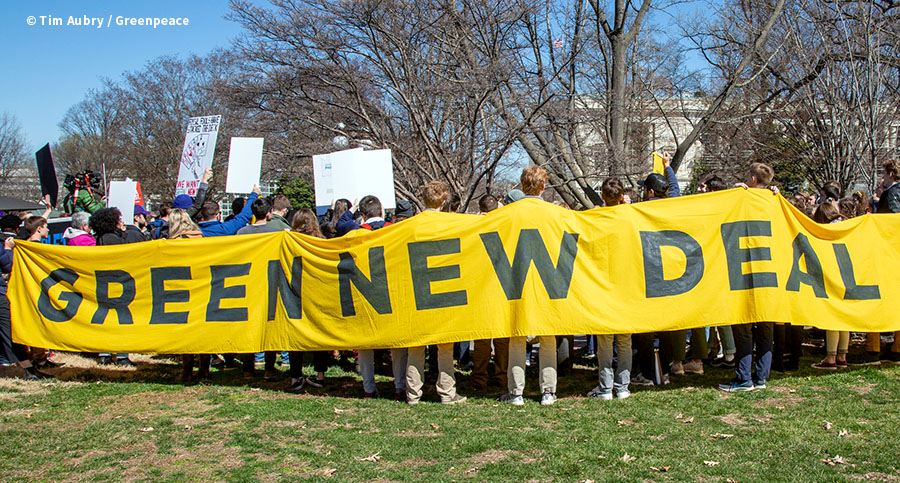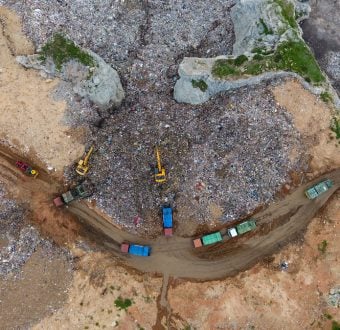There is a plan to kill off the Green New Deal before it can take root. Trump and his fossil fuel cronies plan to scare voters into thinking that the Green New Deal will take their jobs and cost the United States a ridiculous amount of money. And while their talking points don’t pass the laugh test, the right wing media has gone into overdrive demonizing the plan.
It’s all bogus: a Green New Deal would be a very good investment if we design it right. The alternative — an unchecked climate crisis — would be the real economy and jobs killer.
The Social Cost of Carbon
Economists have designed a metric called the Social Cost of Carbon (SCC) to give a monetary estimate for how much climate change will cost. This value tallies up all the economic costs from increased warming — from sea-level rise, to lower agricultural productivity, to human health — and tells us how much economic damage comes from the emission of one metric ton of climate-polluting carbon dioxide.
Some climate costs are difficult to quantify and there is a debate among economists about the best way to calculate the SCC. Previous estimates estimated social costs of around $42 per metric ton of carbon dioxide emitted [1], but newer studies find that climate costs may be as much as ten times larger. Recent research has found that higher temperatures can actually slow economic growth itself [2], meaning that each ton of emissions extracts an even higher cost than previously thought [3]. Indeed, the latest study finds that each metric ton of carbon dioxide emitted leads to $417 in global climate costs, with India and the U.S. paying the most [4].

Country-level social cost of carbon (Ricke et al. 2018). Data visualization available here.
What exactly does one ton of carbon dioxide represent? On average, each barrel of crude oil leads to about 0.5 metric tons (500 kg) of carbon dioxide emissions over its lifecycle, as it is extracted, processed, and burned as gasoline or other fuel. So the social cost of just one barrel of crude oil comes to around $200 [5]. For comparison, the U.S. consumed around 7.5 billion barrels of oil in 2018.
Each barrel of crude oil that we extract and burn causes around $200 in climate damages around the globe, yet, crude oil is currently trading for about $55 per barrel. That means each barrel of oil that is consumed might actually be a net negative for the economy. Even by more conservative estimates of the social cost of carbon, much of the economic value of oil is eroded by the climate damages its causes.
Poor communities around the globe are the ones that will face the worst of those climate damages, although they are less likely to consume much oil or benefit from oil company profits.
Climate Change Is Going To Cost Us
Adding up those barrels of oil year after year, it’s clear that continuing to allow fossil fuel companies to pollute our climate is going to be a blow for the U.S. economy if we don’t take action.
A recent study by two EPA economists found that total climate damages could reach a whopping $500 billion every year by 2090 under a high emissions scenario [6]. The 4th National Climate Assessment found that the biggest losses were from mortality due to extreme heat, loss of labor productivity, and coastal property destroyed by sea-level rise [7]. Other recent studies warn that rising temperatures could “reduce U.S. economic growth by up to one-third over the next century,” [8] and that delaying climate action quickly increases economic costs [9].
These costs won’t be distributed evenly across the country. Under the business as usual scenario, counties in the U.S. South and Midwest will suffer the most damages — notably from declining agricultural yields, increased mortality, and increased energy expenditures [10].

Total direct climate change damages as a percent of county GDP for years 2080-2099, RCP 8.5 scenario (Hsiang et al. 2017)
The good news is that the fastest way out of this crisis involves investing in renewable energy, energy efficiency, and creating large numbers of jobs in sustainable sectors in the process. One study found that the investments required to reduce emissions 80% by 2050 would create an average of 550,000 net jobs over that time period while actually saving $78 billion [11]. A recent report from the Roosevelt Institute described a pathway to financing a Green New Deal that relies on public investment to mobilize unused capacity in the economy and eliminate the risk of severe climate impacts on our communities [12].
What’s a Planet Worth Anyway?
Now, of course, by talking about climate change purely as an economic question we are missing something vitally important. To quote the late climate economist Frank Ackerman, “there are many crucially important values that do not have meaningful prices. […] No price tag does justice to the dignity of human life or the natural world” [13].
But understanding the economics of climate change makes it clear that it would be a very, very good idea to make a down payment now to make the switch to 100% clean energy and avoid the costly — and dangerous — consequences of climate disaster down the road. A big investment in renewable energy and a just transition — like that envisioned by the Green New Deal — helps protect the only planet we have, and ensures that future generations will be able to enjoy the bounty of a healthy environment.
References
[1] Interagency Working Group on Social Cost of Greenhouse Gases. 2016. Technical Support Document: Technical Update of the Social Cost of Carbon for Regulatory Impact Analysis Under Executive Order 12866. August. [link]
[2] Burke, M., S. Hsiang & E. Miguel. 2015. Global non-linear effect of temperature on economic production. Nature Climate Change, 527, 235-239. [link]
[3] Moore, F. & D. Diaz. 2015. Temperature impacts on economic growth warrant stringent mitigation policy. Nature Climate Change, 5, 127-131. [link]
[4] Ricke, K., L. Drouet, K. Caldeira & M. Tavoni. 2018. Country-level social cost of carbon. Nature Climate Change, 8, 895-900. [link]. See also data visualizations at [link]. Note the reported value has large uncertainty and could be as low as $177/ton and as high as $805/ton.
[5] ($417/metric ton CO2) x (0.5 metric ton CO2-eq/bbl) = $208 / bbl. It is worth noting that revenues from selling a barrel of oil are not the only measure of its economic impact, because energy use allows other economic activity to happen.
[6] Martinich, J. & A. Crimmins. 2019. Climate damages and adaptation potential across diverse sectors of the United States. Nature Climate Change, 9, 397-404. [link]
[7] U.S. Global Change Research Program. 2018. Impacts, Risks, and Adaptation in the United States: Fourth National Climate Assessment, Volume II [Reidmiller, D.R., C.W. Avery, D.R. Easterling, K.E. Kunkel, K.L.M. Lewis, T.K. Maycock, and B.C. Stewart (eds.)]. doi: 10.7930/NCA4.2018. See Chapter 29: Reducing Risks Through Emissions Mitigation, Figure 29.2: Projected Damages and Potential for Risk Reduction by Sector. [link]
[8] Colacito, R., B. Hoffmann, & T. Phan. 2018. Temperature and Growth: A Panel Analysis of the United States. Federal Reserve Bank of Richmond. Working Paper No. 18-09. [link]
[9] Daniel, Litterman & Wagner. 2019. Declining CO2 price paths. Proceedings of the National Academy of Sciences, Oct 2019, 201817444. doi: 10.1073/pnas.1817444116. [link]
[10] Hsiang et al. 2017. Estimating economic damage from climate change in the United States. Science, 356, 1362–9. [link]
[11] Labor Network for Sustainability, 350.org, Synapse. 2015. The Clean Energy Future: Protecting the Climate, Creating Jobs, Saving Money. [link]
[12] Paul, M., A. Fremstad & J. Mason. 2019. Decarbonizing the U.S. Economy: Pathways Toward a Green New Deal. Roosevelt Institute. June. [link]
[13] Ackerman, F. 2008. Climate Economics in Four Easy Pieces. Development, 51, 325–331. [link]



